With Bonnie Stewart, EarthFix
Beside Seattle’s notoriously polluted Duwamish River, an excavator scoops up small pieces of waste metal and slings them onto a rusty mountain at Seattle Iron & Metals Corp. A pile of flattened cars and trucks squats nearby amid vast sheets of scrap metal.
For at least the last four years, this auto-shredder and metal recycler has dumped more pollutants into the river than allowed under the federal Clean Water Act, government records show. The levels have ranged higher than 250 times above what’s known to harm salmon that migrate through the river.
The company, which declined to comment for this story, has reported its violations to the government, as required by law. But instead of punishing the metal recycler, the Washington Department of Ecology encouraged the company to reduce its pollution levels. The agency also searched for a legal way to make Seattle Iron & Metals’ pollution limits more lenient, and says it plans to relax them soon.
The Seattle Iron & Metals story is emblematic of widespread failures in the nation’s efforts to end the toxic pollution that modern life has unleashed on America’s rivers, lakes and bays. The Clean Water Act, passed by a large bipartisan majority of Congress 40 years ago, was intended to eliminate water pollution by 1985. Congress declared: “It is the national policy that the discharge of toxic pollutants in toxic amounts be prohibited.”
Yet in the Pacific Northwest, as across the nation, the Clean Water Act has fallen far short of its goals. A majority of Northwest waterways fail to meet federally approved water-quality standards. An investigation by EarthFix and InvestigateWest reveals:
- Whole categories of polluters are effectively exempt from penalties when they dump pollutants illegally. This affects thousands of facilities.
- Violations of the Clean Water Act in the Northwest occur routinely, yet citations and financial penalties are relatively rare.
- Government bodies are among the most prolific violators, especially those that manage aging sewage-treatment plants and stormwater pipes that dump polluted rainwater runoff directly into waterways.
The U.S. Environmental Protection Agency, which is ultimately responsible for enforcing the Clean Water Act, has handed over that responsibility to 46 of the 50 states, including Washington and Oregon. In Idaho, the EPA handles that job.
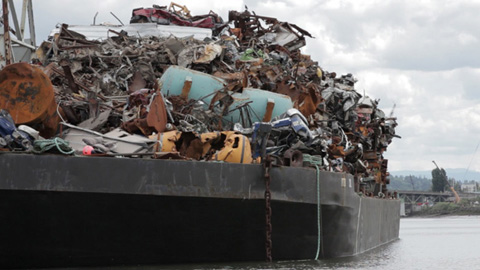
For at least four years, Seattle Iron & Metals has dumped more pollutants into
the Duwamish than allowed under the Clean Water Act, government records show.
Katie Campbell/EarthFix
Impaired waters in the Northwest
Partially as a result of lax enforcement, large proportions of Pacific Northwest waterways violate water quality standards set under the Clean Water Act. These waterways, deemed “impaired,” are unfit for their intended uses, including swimming, fishing, drinking, boating and giving places to live to fish and wild animals. In Washington, about 80 percent of tested rivers and streams are impaired. That figure is 67 percent in Oregon and 55 percent in Idaho. Nationwide the figure is estimated at nearly 40 percent.
And these are only the waters that have been tested. None of the states in the Pacific Northwest has fully checked out all its waterways.
According to the latest figures available from EPA, Washington has fully assessed only 3 percent of its rivers and streams. Oregon has evaluated 40 percent of its rivers and streams, and Idaho has appraised 60 percent. (Because the states have different systems for judging what constitutes a full assessment of a waterway, those numbers are not directly comparable.)
Failure to assess waterways matters. The quality of a body of water is used to determine how much pollution it can handle: the cleaner a body of water, the more likely additional pollution can be allowed.
These pollution assessments are used to set the discharge limits for companies like Seattle Iron & Metals, and for cities and others holding permits to discharge pollution.
In a recent interview with EarthFix, the EPA’s top administrator, Lisa Jackson, said lack of assessment remains an issue nationally. One-third of the nation’s waterways that are supposed to be “fishable and swimmable” are not, she said.
“And that’s just a third of the ones we know about,” Jackson said. “We don’t assess all our waters.”
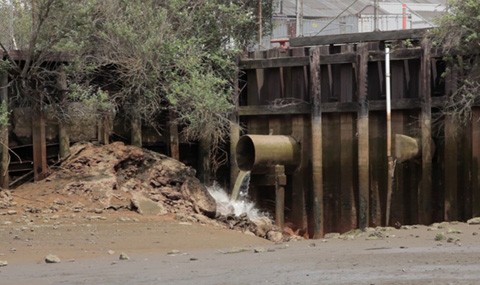
A pollution discharge pipe along Seattle’s Duwamish River.
Katie Campbell/EarthFix
Licenses to pollute
Instead of ending pollution by 1985, as Congress envisioned, the Clean Water Act has evolved into a system that makes it legal to pollute.
It didn’t start out that way. In the two decades that followed the law’s passage, it curtailed the worst toxic pollution of industry and government.
“The water quality in Idaho – and this is true nationally – is way better,” said Justin Hayes, program director of the Idaho Conservation League. “The Clean Water Act has had amazing beneficial impacts.”
In Oregon, regulators point to extensive water quality improvements for the Willamette and Tualatin rivers. The Willamette, once so fouled by industrial wastes that it became a Superfund site, has been cleaned up enough that this weekend it will be the site of the annual Portland Bridge Swim, a race that passes under all 11 bridges over the river in the city.
“Do we have fishable and swimmable waters everywhere that was set in the goal? Well, not everywhere. But we certainly have improved our water bodies a lot,” said Dick Pedersen, director of Oregon’s Department of Environmental Quality. “… But we still have a long way to go.”
Here’s how the Clean Water Act was supposed to work: Each polluter gets a permit – a legal right to dump wastewater with set concentrations of pollutants. Then, every five years when the permit has to be renewed, lower pollution limits made possible by updated technologies were supposed to kick in. Eventually, pollution would be eliminated.
“Well, that turned out to be not feasible, or possible or practical,” Pedersen said.
Four decades later, Pedersen’s department and regulators in other states are having trouble simply keeping up with permit renewal cycles, which means dischargers continue to pollute based on out-of-date permits.
According to an Oregon DEQ report, for example, more than two-fifths of polluters were operating on out-of-date permits at the end of 2011.
Polluters escape scrutiny
Not only are hundreds of permits out of date in the Pacific Northwest, some categories of polluters aren’t even monitored for violations.
Regulators in Oregon have stopped reviewing some reports companies and institutions have to file detailing the levels of pollution in their discharges. These reports are supposed to alert regulators to violations.
A lack of resources has affected the ability of regulators to adequately review all discharge reports, DEQ’s Pedersen said. “So we have to triage and prioritize what we do with the fewer staff that we have.”
In the agency’s northwest office, the loss of one worker left the equivalent of 3.5 full-time employees to review the discharge reports for more than 1,600 pollution permits. The same 3.5 employees also have to develop new permits, renew expiring permits, conduct on-site inspections and write and follow through on enforcement actions.
As a result of the staff loss, regulators in that office quit reviewing the discharge reports filed by 163 permit holders. Those included vineyards, fisheries and the sewage treatment plants of a few small cities.
Similar staffing issues have stymied Washington’s Ecology Department enforcement efforts. Two years ago it stopped pursuing violations that come to light in discharge reports covered by certain classes of pollution permits, said Nancy Kmet, an Ecology environmental engineer.
The polluters who are getting a free pass include boatyards, gravel miners, fruit packers and industrial facilities of various stripes – more than 4,400 companies, Ecology records indicate.
“We don’t have the staff to address thousands of violations,” Kmet said. “We do the best we can.”
An interactive map of Clean Water Act penalties in Washington, Idaho and Oregon since 2009
Jason Alcorn/InvestigateWest and Bonnie Stewart/EarthFix
Permit violations
Even when regulators do flag polluters who are violating their permits, government databases indicate they seldom face fines or enforcement action. Over the last 3 ½ years in Washington, only 55, or about 10 percent, of the 572 polluters who reported dumping in excess of legal limits faced formal enforcement action, and just 6 percent faced fines, records show. In Idaho, the figures were 20 percent and 11 percent.
Comparable figures aren’t readily available in Oregon because of the state’s lack of computerized records. However, information is available about how polluters classified as “major” compare in the three states. According to the EPA’s Environmental Compliance History Online database and Washington’s Permit and Reporting Information System:
- In Oregon, 64 percent of the facilities reported violating limits on how much they could dump, but no more than 18 percent faced formal enforcement action such as an administrative order or a fine.
- In Idaho, 52 percent of the polluters violated their permits, but no more than 22 percent faced binding enforcement action.
- In Washington, 74 percent violated the permits but only 18 percent faced binding enforcement action.
State regulators say they are too short-staffed to go after every violation – and that they don’t want to move immediately to punitive measures when a more collaborative approach can bring many polluters into line.
“You can fine them a whole bunch of money. Another way is you can work with them and try to bring them into compliance,” Pedersen said.
Violations ignored
The EPA has called states out for poor enforcement. The federal agency’s inspector general reported in December 2011 that state enforcement programs for the Clean Water Act and two other environmental laws “are underperforming,” remarking “performance is low across the board.”
“Noncompliance is high and the level of enforcement is low,” inspectors reported. “EPA does not consistently hold states accountable for meeting enforcement standards, has not set clear and consistent national benchmarks, and does not act effectively to curtail weak and inconsistent enforcement by states.”
It’s a nationwide problem, affecting even major polluters classified as being “significant non-compliers.” In a 2007 report, EPA auditors who reviewed 44 of the approximately 3,600 major factories, sewage-treatment plants and other facilities regulated under the Clean Water Act nationwide found long delays in enforcement over a three-year period. That tiny fraction of the nation’s polluters dumped 51 million pounds more pollutants than allowed under the law over the three-year period, the EPA Inspector General reported.
In the Northwest, “We are having no trouble finding people in gross violation of their permits,” said Chris Wilke, executive director of the Puget Soundkeeper Alliance. “You pull 20 files and you may easily find five or ten that are in violation.”
Wilke’s Seattle-based environmental group files lawsuits against polluters alleging violations of the Clean Water Act. Last week it sued Seattle Iron & Metals Corp.
Beyond these suits to enforce the Clean Water Act on specific polluters, environmentalists also have repeatedly and successfully filed broader lawsuits in all three states claiming that the government is failing to carry out the law. Such suits have forced states to adopt stricter water-quality standards and to mandate clean-up plans, for example. But even those changes have not been enough to bring pollution under control.
State regulators know there are problems.
Over the last two decades Washington’s Department of Ecology has been getting more money and staff for its water-quality division, with its budget nearly tripling since 1994. However, over the same period, the number of permits under its watch has greatly increased.
Those budget increases also came with additional responsibilities, including a lot of emphasis on controlling polluted rainwater runoff, said Don Seeberger, deputy program manager of Ecology’s water-quality division. Yet the agency is partly dependent on the very businesses that it regulates. Permit fees help fund government oversight, and those fees drop when recessions hit.
“We know that the more inspections you do, the better the compliance with the regulations,” Seeberger said. “It’s not whether we have the work. It’s whether we have the money.”
Understaffing is not the only factor driving the underenforcement noted by EPA inspectors, though.
Even with all the staffers he could want, “I think it would be a mistake to go after every single violation, at least until you understand the violation,” said Kelly Susewind, manager of the Washington Ecology Department’s clean-water program.
Susewind said the agency will start going after violations of dumping permits identified in the discharge reports at some point. When? “I can’t give you a date, but it’s not far in the future,” he said. Pressed for a time frame, Susewind said, “The next few years.”
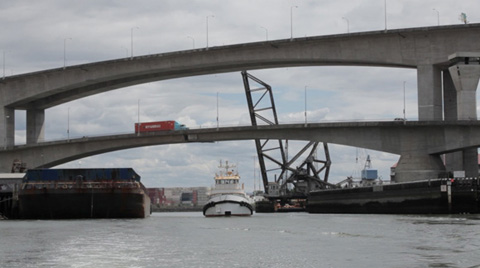
Commercial boat traffic on Seattle’s Duwamish River.
Katie Campbell/EarthFix
The tolerant approach
Instead of using their punitive enforcement tools right away, both Oregon and Washington have chosen a friendlier path.
Susewind said the reason relatively few Clean Water Act violators face fines or other enforcement actions is that regulators have opted to first offer violators technical assistance. Next comes what the agency calls education. And if that doesn’t work, a lawbreaker may get a nasty letter from the agency, classified as an “informal enforcement action.”
Only a small number of facilities require formal enforcement efforts, Susewind said. That means issuing a citation, and possibly a fine. But Ecology really doesn’t want to see that happen, he said, because most polluters want to do the right thing.
While a violation is ongoing, Ecology tries to “understand the circumstances that led to that (violation),” Susewind said. “Sometimes it’s something that’s beyond someone’s control. Is it something they’ve corrected that we’re confident won’t happen again?
“If it’s an ongoing violation, are they taking all the steps necessary to eliminate it? And if they aren’t complying and aren’t on a path to comply, then we step to our next resort, which is formal penalties.”
Oregon regulators have adopted a similar philosophy, first working with permit holders to help them comply with their limits. But in cases where the permit holders know what to do, that changes.
“If it’s just poor operation and not meeting conditions, then I don’t think we should have a whole lot of patience on that at all,” Pedersen said.
John Ledger, vice president of Associated Oregon Industries, said Oregon’s enforcement process is not unreasonable. Regulators go through a long series of decisions before taking action, he said.
“Willful violations are looked at askance by everybody,” he said. It’s just like driving a car, he said. “No one likes a reckless driver.”
Government is part of the problem
While many of the worst industrial polluters were brought under control decades ago, it’s government-run facilities that turn up more and more as the worst water polluters.
The North Idaho Correctional Institution, for example, racked up 4,048 violations of the Clean Water Act in just 4 ½ years, according to EPA records.
The violations are largely the result of the prison’s antiquated sewage treatment system. The facility, built on Radar Road, started life as a Cold War-inspired radar installation built by the U.S. Air Force in 1956. It was finished in 1959, but deemed obsolete by the mid-60s. Then in 1974 the state grabbed it for a minimum-security prison.
Today, the facility’s sewage treatment system is in such disrepair that state officials say they may have to spend up to $6 million to fix it.
The prison near Cottonwood, Idaho, houses up to 414 lawbreakers, while breaking the law itself by dumping sewage into an unnamed stream that flows into Lawyer Creek.
To satisfy the EPA, the Idaho Department of Corrections in April agreed to study the system to figure out what’s wrong.
“EPA has been great to work with,” said Josh Tewalt, deputy director of the Idaho Department of Corrections.
Although required to get a permit under the 1972 Clean Water Act to dump sewage, the prison did not do so until 2004. Tewalt said that permit – still in effect even though it was to have expired in 2009 – set pollution limits that were too strict.
“No one is killing fish. Are we in violation of our permit? Yes,” Tewalt said. “Are we talking about severe environmental degradation and killing fish? Absolutely not.”
Lawyer Creek, where the prison’s discharge ends up, violates Clean Water Act standards for fecal coliform, ammonia and nutrients, according to EPA records. Those pollutants often come from sewage and are harmful to coldwater fish. The EPA classified the creek as “impaired” for swimming and other direct contact by people.
“The bottom line for exceeding a permit is, it’s against the law,” said Sara Arkle of the Idaho Conservation League. “If everybody were allowed to exceed their limits, we’d have really dirty water.”
In May the state signed a consent agreement that obligates the prison to study the situation and submit a plan to fix the problems by April 1, 2014.
Robert Grandinetti, a U.S. EPA compliance official, said his agency cannot explain why this facility is only now addressing problems that presumably date back many years.
“I can’t give you a great reason why it took so long other than they weren’t a priority,” Grandinetti said.
A recent count of facilities with a double-digit number of dumping violations in Idaho since January 2009 showed that 20 of the 25 were government-run.
In Seattle, the government-run King County International Airport, also known as Boeing Field, dumps its stormwater runoff into the Duwamish just upstream from Seattle Iron & Metals. It’s also one of the latest targets of lawsuits by the Puget Soundkeeper organization. The pipe carries stormwater, the foul rainwater runoff that flows off hard surfaces such as streets, parking lots – and in this case, tarmac – that regulators and others agree is one of the most widespread and intractable of the nation’s water-pollution problems.
“We’ve seen it puking muddy water. We’ve seen it discharging orange water,” says Wilke of Soundkeeper.
Rochelle Ogershok, a spokeswoman for King County, wrote in response:
“King County Airport staff work diligently to comply with all requirements of the Clean Water Act … Even before the lawsuit was filed, the airport was already in the process of installing over $2 million in additional capital improvements to address stormwater runoff.”
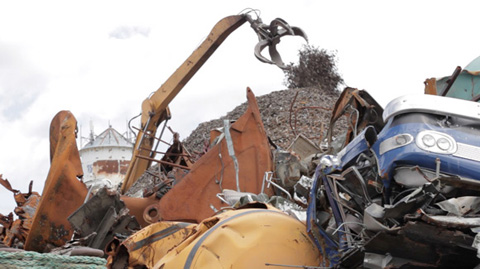
Seattle Iron & Metals’s facility on the Duwamish. Washington’s Ecology Department has proposed granting the company a “mixing zone.”
Katie Campbell/EarthFix
Ending pollution by permitting it
Environmentalists contend there are several legal loopholes in the way the Clean Water Act is being enforced that have hampered their efforts to make waterways more pristine. One of those loopholes is pertinent to the Seattle Iron & Metals case.
The company has been dumping zinc and copper — two highly toxic heavy metals – into a stream already so polluted that it’s been declared a Superfund site.
Both metals are harmful to fish. Even at trace concentrations, copper stuns salmon, causing them to lose their crucial sense of smell. Zinc leads toaltered behavior, changes in body chemistry, impaired reproduction and reduced growth. The amount of copper the company reported dumping into the Duwamish was up to 18 times the level that affects salmon. For zinc, it was more than 260 times what’s known to harm the fish.
Washington’s Ecology Department issued a violation notice to Seattle Iron & Metals in August 2008 – eight months after the company first reported violating its permit, records show. That was nearly four years ago. Time passed, and the violations continued.
Now Ecology is proposing a solution: The agency plans to grant the company what’s known as a “mixing zone,” said Ecology’s Ed Abbasi, the staffer assigned to the case.
Basically, that means that materials can be dumped in toxic amounts, as long as regulators are convinced the effects of dilution will make it non-toxic by the time it reaches a specified distance from the dump site. Mixing zones are controversial, since they are not explicitly permitted in the Clean Water Act, but rather by an interpretation of the law by EPA.
Records show the company asked for a mixing zone in 2002, but it was not granted.
In more recent years the company’s pollution levels have remained high, Abbasi acknowledged. However, the company worked to reduce pollution in accordance with Abbasi’s recommendations. That, he said, explains why he did not level any fines. It also made the company eligible for a mixing zone.
“They have been improving their discharge,” Abbasi said. “They are under an order to make improvements.”
He said the new permit, which he expects to issue later this year, would reduce the company’s zinc discharges to about one-sixth the highs the company was seeing in the past. Under the zinc limit Abbasi said he plans to impose, the company’s zinc discharge would still be 45 times higher than levels studies show harm fish.
Seattle Iron & Metals is only one of about 6,000 facilities permitted to dump pollution into Washington’s waters.
Just as Puget Soundkeeper Association has sued Seattle Iron & Metals and numerous other businesses in the Puget Sound area, Columbia Riverkeeper filed lawsuits against a number of firms on both sides of the Columbia River. The Hood River, Ore.,-based environmental group has used the citizen’s suit provisions of the Clean Water Act to go after log yards, scrap yards, plastics manufacturers, truck yards and, memorably, a shipping terminal where lots of bulk chemicals including petroleum coke and potash were stored in the open so that pollutants were carried away in rainwater runoff.
Columbia Riverkeeper’s director, Brett VandenHeuvel, said lawsuits like these are a measure of how much progress remains for the Clean Water Act to work as it was intended.
“In 1972 we were going to stop using our rivers as dumping grounds and we’re nowhere near there,” VandenHeuvel said. “State and federal regulators don’t even try to meet that goal any more and that’s a problem.
“That’s a colossal failure.”
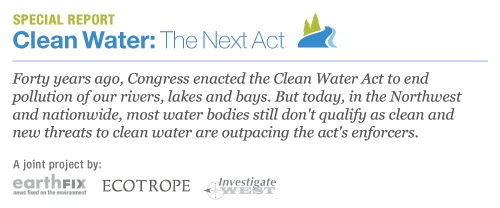
InvestigateWest is a non-profit newsroom based in Seattle that covers the Pacific Northwest. EarthFix is a public media project of seven NPR and PBS stations in Washington, Oregon, and Idaho. There’s more to come in our series, “Clean Water: The Next Act”
- Development-related pollution in the form of rainwater runoff poses an increasing threat to water quality.
- Clean water isn’t just under threat from big facilities, urban development, and runoff from suburban sprawl. In the rural Northwest, logging and farming practices are degrading our rivers and streams.
- Waterways increasingly contain potentially dangerous residues of the lotions, potions and pills that keep us well and clean and smelling nice – a threat the Clean Water Act was never intended to stem.
- Sewage treatment remains a major source of water pollution, with increasing numbers of governments struggling financially and beset by aging wastewaster treatment facilities.
This story was updated July 25, 2012 to reflect that the states have different criteria for considering a waterway fully assessed.




Is there a way that the EPA could have programs as coursework for those with highschool or community college degrees to be inspectors and or fee collectors? Costs and the will/time to get a program out there non withstanding, clean water is a necessity and a public health issue.